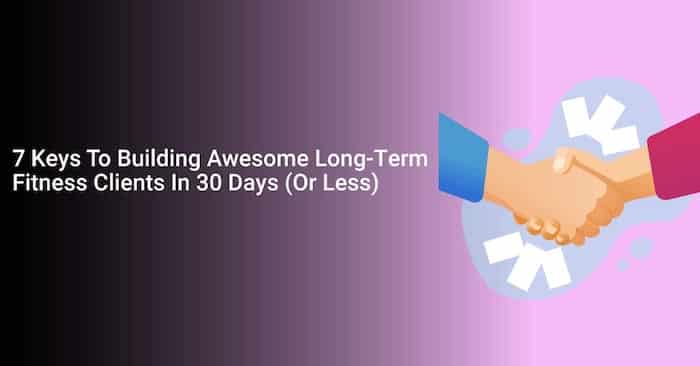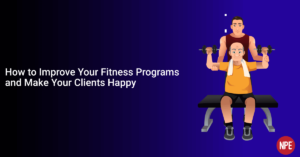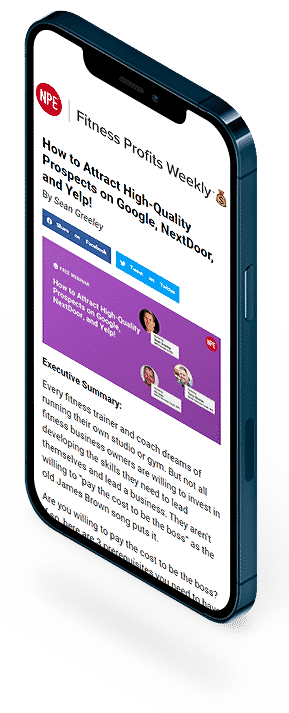7 Keys To Building Awesome Long-Term Fitness Clients In 30 Days (Or Less)
By Sean Greeley

In my last article, I talked about the power (and dangers) of offers in marketing.
I also made the point that the goal of a trial offer is NOT to make a sale to a customer – it’s to acquire a long-term client for your business.
Anything else just isn’t worth your time.
At its core, good marketing should be about good business practices.
If the two aren’t congruent, then you’ve got some adjustments to make on one side or the other until they match up.
Here’s a powerful question for you to answer:
“How can I build an awesome long-term client for my business in 30 days or less?”
When you know the answer to that question, and can systemize the fulfillment of the process, and then take it back into your marketing as a paid trial offer… well that’s magic in a bottle.
So, let’s explore that topic further with seven keys that are critical to success:
- Meet Your Prospect Where They’re At

If you want to build great clients, you’ve got to take time to understand your prospect inside and out.
You are not your prospect.
I’m going to go out on a limb here and suggest that the majority of prospects you are speaking with DO NOT want to lose weight, fit in their skinny jeans, have six-pack abs, or tickets to the gun show.
What they really want is to feel better about themselves. To have more energy. To have more confidence. To feel more “in control” and have a better balance between all the demands pulling at them in their life between work, family, and more.
And as the saying goes, “No one cares how much you know until they know how much you care.”
What problems or challenges are your prospects facing?
How do they feel about them?
How are those problems or challenges affecting their life?
What do they truly desire? (HINT: it’s probably not what you think)
Too many professionals are such experts in assessment, programming, nutrition, strength, mobility, and more… that it’s all too easy to forget the day-to-day challenges your market (and prospect) is facing.
It’s difficult to relate to what it feels like to walk a mile in their shoes.
But you must get to that level of understanding, compassion, and empathy for your prospect.
Without that level of understanding, everything you have to say is just noise and off message.
- Let Them Know Who You Are and What You Stand For
People want to do business with people.
When someone hires you as a fitness professional, they are asking for your help in solving a very challenging problem in their life.
And they must first trust you before they can put their faith in you.
That means they want to get to know who you are and what you stand for.
Share your story with them.
What inspired you to become a fitness professional?
What do you stand for?
Why do you do what you do every day?
Where are you going?
Let them into your life and inspire them to enroll in your mission with you.
- Be Authentic in Your Message and Promises
All young marketers make mistakes here, myself included.
Because unfortunately most marketing education (and things we see and model) teach us to make outrageous claims.
And it’s a race to see who can make more outrageous claims and promises.
Get ripped in 30 days!
Lose inches and drop 4 dress sizes in 2 weeks!
Add 20 pounds of muscle in 4 weeks!
Now are those things possible?
Maybe.
But when you start your marketing and client relationship with outrageous promises and messaging, you create some problems from the start:
- Nobody really believes you (and if they do…)
- Nobody believes in themselves
And that’s a tough place to begin.
Because at the end of the day, this whole thing is NOT about you. It’s about your prospect.
As a coach, your goal is to build their confidence and belief in themselves.
Without that, they’ll struggle to pursue the path that will get them to the big goal and results you wish for them to have when it’s all said and done.
- Welcome Them into the Community

Welcoming clients is about introducing them to others, helping them to make new friends with people on the same path they’re on, and creating bonds that are fun and supportive of their goals.
This also holds the power to dramatically improve their success rate (which in turn builds confidence, belief system, and keeps your new clients coming back for more).
Perhaps you have heard of the Yale (or Harvard Business School) study of goals in which only 3% of the graduating class had specific written goals for their futures. Twenty years later, that 3% was found to be earning an astounding 10 times that of the group that had no clear goals.
Well, it turns out that study is merely an urban myth.
But Dr. Gail Matthews from Dominican Republic and Dr. Steven Kraus from Harvard conducted their own study on five groups of 267 participants ranging in age from 23 to 72 who were recruited from the United States, Europe, Australia, and Asia.
The study included a variety of entrepreneurs, educators, health care professionals, artists, attorneys, bankers, marketers, human service providers, managers, vice presidents, and directors of nonprofits.
The participants were randomly assigned to one of five groups.
Group 1 was simply asked to think deeply about their goals – what they wanted to accomplish over the next four weeks – but not to write them down.
Groups 2, 3, 4, and 5 were asked to write down their goals.
Group 3 was asked to also formulate a list of action commitments.
Group 4 was asked to formulate a list of action commitments and then send their list of goals and action commitments to a supportive friend.
Group 5 was asked to do all the above, and provide a weekly progress report to a friend.
At the end of four weeks (hint, hint… 30 day trial period!), the participants were asked to rate their progress and the degree to which they had accomplished their goals.
The participants in Group 1 accomplished only 43% of their goals, while participants in Group 5 achieved 76% of their goals.
That’s a 33% increase over Group 1.
This study provides the empirical evidence for the effectiveness of three coaching tools: accountability, commitment, and writing down one’s goals.
Writing down one’s goals is proven to enhance goal achievement.
That’s powerful and good for everyone involved.
- Build Their Confidence
Confidence in any endeavor grows as we take small steps towards our goals and build momentum.
Just like a trainer that carefully designs a series of progressive fights for a boxer to win before they put them into the ring for a big championship, you must do the same for your new client.
What are simple habits you can give them that they ABSOLUTELY cannot fail with?
How about 10 minutes of exercise each day?
How about getting more sleep?
How about just being conscious of what they are eating?
Or adding some protein to each meal?
Whatever you do, keep it simple.
Don’t overwhelm them.
Your goal with a new client shouldn’t be to get amazing results out of the gate.
It’s to build momentum and confidence towards the work to be done long term in achieving their goals.
- Celebrate Wins (Use a Physical Representation)
I’ll be the first to admit that I’m terrible at this.
I don’t celebrate enough.
I find it all too easy to accomplish a big goal, put my head down, and keep charging after the next one.
I know many other top performers that are similar in that regard.
The “fun” for me is in the journey.
But that’s not always best for others and certainly isn’t best for your new client.
Take the time to celebrate and recognize their accomplishments.
There are tremendous examples of this in the fitness community.
Beach Body gave away Insanity T-shirts to everyone who completed the program and sent in their story.
Spartan Race gives out medals to all who finish each event (including special medals that must be combined with other medals to be completed – hint: encourages repeat purchases!).
We give out certificates (and more) when someone completes one of our programs, along with recognizing them in our private Facebook groups and weekly newsletters (and other media).
You should be doing the same.
Make it a big deal to “graduate” and complete a trial period.
Human beings are striving to be loved. Recognition is a form of love. And most adults rarely get any recognition in their life.
That all stopped after leaving high school.
But you can give them that here and now.
- Give Them the Next Milestone and Repeat
After the celebration is complete, give them the next challenge (and convert your trial buyer into a long-term client).
Use the same principles you learned in the first 30 days to continue their success in the next cycle.
Progressive challenges (and wins) are how we grow over time.
That’s good coaching practices for your clients AND smart marketing strategy for growing your business.
Summary
The goal of all your marketing should be to acquire long-term clients for your business.
Instead of thinking through strategies on how to make a quick sale, take the time to get clear on how to build a customer into a great long-term client.
When you’re clear on that process (and I’ve outlined several keys for you here), then market and sell THAT as your paid trial period.
Make sense?
Good.











